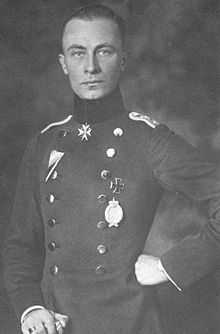Jagdstaffel 23
| Jasta 23 | |
|---|---|
| Active | 1916–1918 |
| Country | German Empire |
| Branch | Luftstreitkräfte |
| Type | Fighter squadron |
| Engagements | World War I |
Royal Bavarian Jagdstaffel 23b was a World War I "hunting group" (i.e., fighter squadron) of the Luftstreitkräfte, which was the forerunner to the Luftwaffe. As one of the original German fighter squadrons, the unit would score a minimum of 63 verified aerial victories. They scored twelve wins over enemy observation balloons as a squadron.[1]
In turn, their casualties for the war would amount to 14 pilots killed in action, one killed in a flying accident, nine wounded in action, and two taken prisoner of war.[1]
History

Royal Saxon Jagdstaffel 23 was established on 25 October 1916 at Metz-Frescaty. It would not gain a commanding officer until 17 November. The jagdstaffel finally came ready for action on the last day of the year. The following day, 1 January 1917, Jasta 23 moved into action at Puxieux. It would not score its first win until 14 February. On 4 July 1917, it was officially designated a Bavarian squadron. It joined the Bavarian Jagdgeschwader IV under command of Eduard Ritter von Schleich on 10 October 1918, and served there for the last month of the war.[1]
Staffelführers (Commanding officers)
- Paul Backhaus
17 November 1916 - 4 August 1917
4 August 1917 - WIA 29 May 1918
- Heinrich Seywald
2 June 1918 - WIA 29 June 1918
- Fritz Krautheim (WIA)
2 July 1918 -WIA 19 July 1918
- Heinrich Seywald
19 July 1918 - 11 November 1918[2]
Aerodromes
1. Armee-Abteilung Strantz: 25 October 1916 - 1 January 1917
2. Pusieux, Mars-la-Tour: 1 January 1917 - 14 April 1917
3. Erlon, France: 16 April 1917 - 14 July 1917
4. Jametz, France: 20 July 1917 - 24 November 1917
5. Saint-Mard, France: 24 November 1917 - 4 February 1918
6. Aniche: 6 February 1918 - 16 March 1918
7. Émerchicourt, France: 17 March 1918 - 27 March 1918
8. Bapaume, France: 27 March 1918 - 18 April 1918
9. Epinoy, France: 18 April 1918 - 27 August 1918
10. Lieu-St.-Armand: 27 August 1918 - 25 September 1918
11. Bühl, Germany: 27 September 1918 - 8 October 1918
12. Harmignies, Belgium: 13 October 1918 - 5 November 1918
13. Fleurs, France: 5 November 1918 - 11 November 1918[2]
Notable members
- Otto Kissenberth Pour le Merite, Royal House Order of Hohenzollern, Iron Cross[3]
- Balloon buster Friedrich Ritter von Röth Pour le Merite, Hohenzollern, Iron Cross, Military Order of Max Joseph[4]
- Michael Hutterer Iron Cross[5]
- Theodor Rumpel Iron Cross[6]
Other aces serving in the unit were Karl Schattauer, Heinrich Seywald, Albert Haussmann, Max Gossner , and Albert Dietlen.[8]
Aircraft
Initial equipment for Jasta 23 was the Albatros D.II fighter. Later, it would be refurnished with Pfalz D.XII and Roland D.VIa fighters.[2]
Operations
Jasta 23 was formed in the Armee-Abteilung Strantz Sector. On 16 April 1917, it moved to the 7th Armee Sector. Its next move, on 18 July, saw it assigned to 5th Armee.[1]
In February 1918, it moved to support 17th Armee at Aniche. On 27 September, it moved to the Armee-Abteilung A Sector; shortly thereafter, on 8 October, it moved on to work for 2nd Armee until war's end.[1]
References
Above the Lines: The Aces and Fighter Units of the German Air Service, Naval Air Service and Flanders Marine Corps, 1914-1918. Norman L. R. Franks, Frank W. Bailey, Russell Guest. Grub Street, 1993. ISBN 0-948817-73-9, ISBN 978-0-948817-73-1.
Endnotes
- ↑ 1.0 1.1 1.2 1.3 1.4 Above the Lines: The Aces and Fighter Units of the German Air Service, Naval Air Service and Flanders Marine Corps, 1914-1918. p. 39.
- ↑ 2.0 2.1 2.2 Retrieved on 8 July 2010.
- ↑ Retrieved on 8 July 2010.
- ↑ Retrieved on 8 July 2010.
- ↑ Retrieved on 8 July 2010.
- ↑ Retrieved on 8 July 2010.
- ↑ Retrieved on 8 July 2010.
- ↑ List developed from Above the Lines: The Aces and Fighter Units of the German Air Service, Naval Air Service and Flanders Marine Corps, 1914-1918. p. 39.
| ||||||||||||||||||